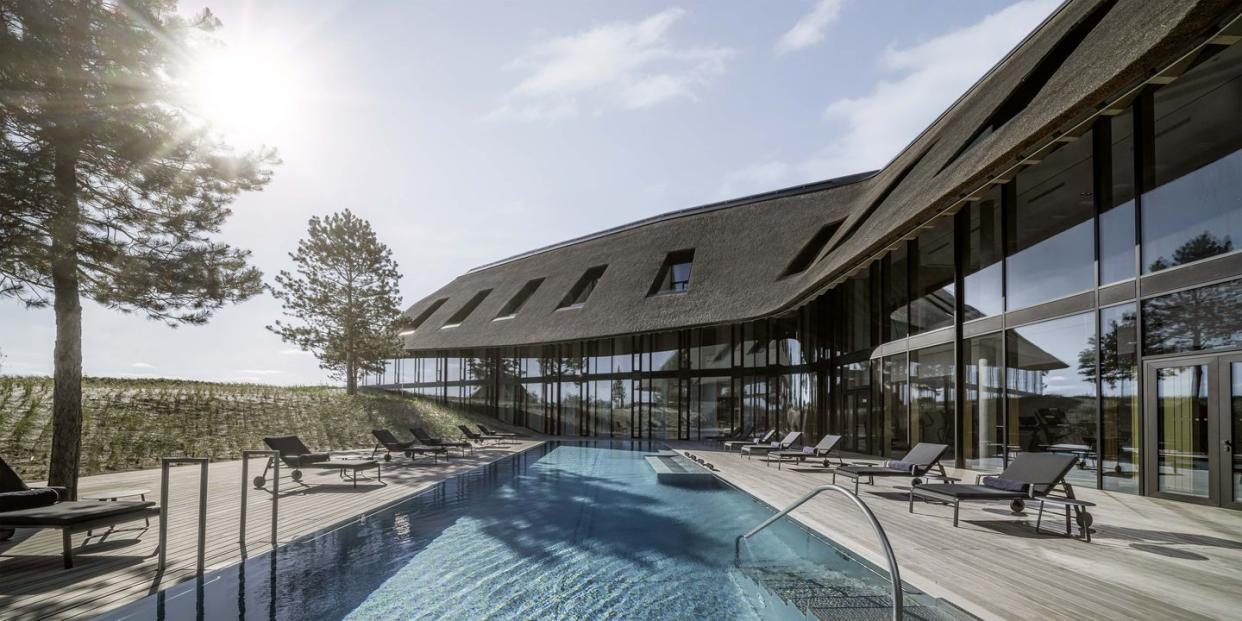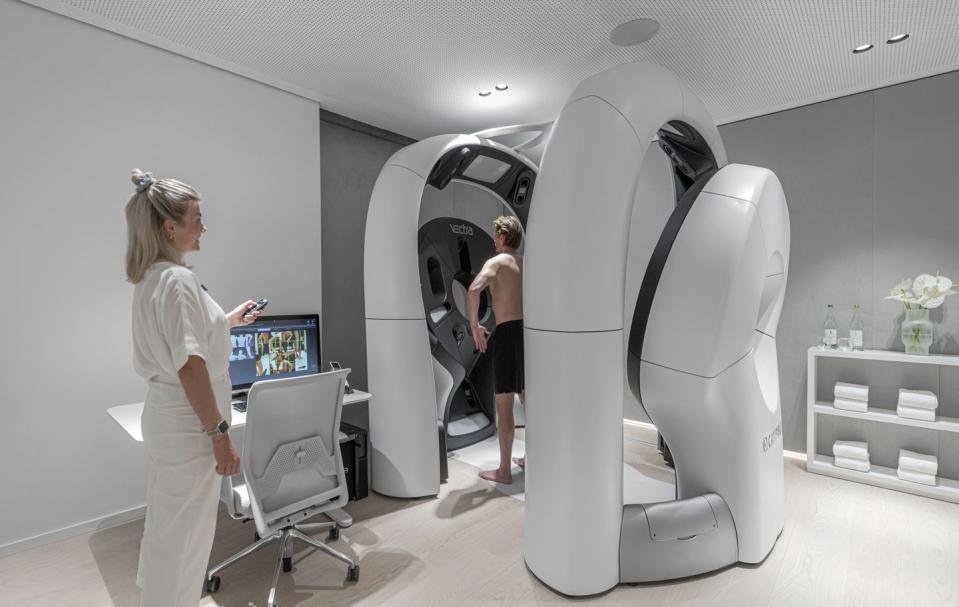Is This The Ultimate Detox?

I’ve always been fascinated with the rejuvenating powers of the sea. Maybe I should blame all the Jane Austen movies I watched with my mother, in which characters were routinely told to “take in the sea air” to recover from a host of illnesses, both physical and mental. In Austen's era, and well before, whole communities were built on coasts to accommodate what now we might refer to as medical tourism.
It's no surprise, then, that the new location of the world renowned wellness clinic Lanserhof is literal steps from the waves, located on Sylt, a tiny, 38-square-mile island on the northern tip of Germany that cuts into the North Sea like a splinter. Long known as the summertime playground of the country’s rich and famous, Sylt is populated with subtle toadstool-like summer cottages that can cost millions. What was once a sleepy island of whalers and fisherman is now the Hamptons of Germany. The traditional aesthetic of thatched roofs has become a trademark. It’s just that now those roofs cover Hermes and Brunello Cucinelli stores instead of barns.
The addition of a highly luxurious wellness clinic isn’t out of place in this enclave. Lanserhof's 125 million euro structure, designed by renowned architect Christophe Ingenhoven, was intended to blend in not only with the traditional aesthetic of Sylt, but with the dunes of the island itself. The result is a sprawling wood and glass building that features nearly uninterrupted views of the surrounding landscape and also the largest thatched roof in Europe.

Getting to Sylt in the off season is no easy feat. The small airport, optimized for private jets and charter flights, isn’t open in the winter. I had endured two planes, one barely-made connection in Paris and a three hour train from Hamburg before finally touching down on Sylt sand. But the moment I stepped off the train and was escorted into the warm cocoon of the “shuttle” (an all-electric Mercedes EQS sedan), my Lanserhof experience began. Shooting down the gray winter coastline like a bullet, before long the thatched roof of Lanserhof Sylt rose from the dunes in front of me.
Everything about Lanserhof Sylt is almost aggressively serene. The hotel part of the building is all blonde wood, greige linen Eames chairs and overstuffed couches, plush earth toned velvets, glass walls, and warm ambient lighting centered around a jaw dropping white spiral staircase that leads to the guest rooms above. The rooms themselves mirror the aesthetic - each of them two stories with ribcage-like beams of light wood that curve over the space along the slope of the roof and have the effect of being inside the stomach of a whale, Pinocchio-style. There is no art anywhere and there is almost never any ambient music. This is all by design, I later learned - to startle our over-stimulated brains into relaxation.

Walking into the medical clinic and “derma” (i.e. the treatments area), however, is like being transported into the future - or at least the set of 2001: A Space Odyssey. Everything is stark white: the floors, walls, furniture, equipment, staff’s uniforms. My first morning, which featured a battery of intake tests and a meeting with Dr. Jan Stritzke, the energetic medical director of Lanserhof Sylt and a cardiologist by training, felt like going to the doctor on a spaceship.
The core of the Lanserhof program, he told me, is fasting. Based on the work of Dr. Franz Xaver Mayr, an Austrian physician whose century old discoveries around the gut microbiome, purification and deacidification of the body in connection to regeneration seem more like regular wellness conversation nowadays, it’s why most patients come to Lanserhof. This usually means four to five days of Level 0, an ultra-minimal diet of vegetable broth that totals around 50-100 calories a day. This helps not only cleanse and reset the gut, but forces the body to burn fat and supercharge other functions like autophagy (the body’s ability to clean out old or damaged cells and create new ones). One of the goals of the Lanserhof fast is to increase both metabolic capacity (the ability to burn fat) and metabolic flexibility (the ability to switch between using fat and blood sugar as fuel when needed).
Guests come to Lanserhof for detoxification, rejuvenation and, most of all, prevention, Dr. Strizke told me in that first meeting. This means something different to everyone, which is why he and his team use the intake diagnostics, personal medical history and long term goals to formulate a custom treatment protocol that combines the type of tests and procedures you’d find at more traditional hospitals with other alternative naturopathic and “wellness” therapies like detox body wraps, massage and lymphatic drainage, mental health coaching, personal training programs and anything else from the extensive list of 286 possible treatments. This also means that not every guest starts at Level 0.
This was good news to me. I’d spent weeks stressing about what the Lanserhof team would ask me to do. For the last five months, my diet and fitness routine had been hyper-focused on gaining weight, not losing it. I was eating close to 6,000 calories a day and had packed on quite a bit of poundage (most of which, I was hoping, was muscle). I was worried not only about getting off track, but of what it would do to my body to essentially go from 6,000 to 50 calories overnight.
Luckily, Dr. Strizke agreed. He advised me to go straight to Level 3, the Active plan with the most food and after two days increase to the Sports plan, which included protein shakes at regular intervals between meals. Lanserhof, he told me, wasn’t only about losing weight or fasting. Plenty of people, including professional athletes, seek out their services to optimize performance, help recuperate from strenuous training or rehab injuries. The plan, he assured me, could be tailored to anyone’s needs. I was also to follow the typical supplement routine: Epsom salts in the morning to flush the colon of bad bacteria, a shot of vitamin-packed wheatgrass and algae oil at breakfast, a concoction of bitter herbs before each meal to help with digestion, and twice daily alkaline powder to help lower the acidity of my body. He also added in mineral and magnesium supplements each day for muscle recovery and a nightly probiotic powder to help repopulate my gut with good bacteria. And, the hardest of all, no caffeine.

The rest of my plan was a mix of preventative and diagnostic tests and procedures, treatments to help detox and repair my body as well as aid in digestion and personal training sessions. There was the Vectra scan, a hulking orb of 92 cameras that created a 3D model of my body in order to detect and track lesions that could be skin cancer; a Heart Rate Variability (HRV) monitor to record my heart rate and nervous system responses over the course of 24 hours; multiple therapeutic massages, reflexology, machine-assisted cupping and a hay body wrap to keep everything moving along happily inside my gut; Cell Gym, a therapy that alternatively deprived and saturated my lungs with oxygen to flush out dead mitochondria and build new ones; and cryotherapy to help stimulate blood flow, release endorphins and reduce inflammation. Even my personal training sessions had a Lanserhof bent to them: one centered around bouldering on the indoor climbing wall (which is so good at stimulating the mind/body connection that it’s used as a therapy for mental health issues like schizophrenia) and another session that focused on mobility and functional movements as well as more traditional weight lifting techniques.
Even without fasting, by the second day I felt a difference in my body. I felt physically lighter, and not just from the morning Epsom salt aftermath. Even Dr. Stritzke was impressed when I went in for my medical check-in and abdominal massage. “It usually takes people three or four days to see this much change,” he said as he placed his hands on my stomach to feel the progress. It was all thanks to the food, which is the core of the Lanserhof experience.
All meals are structured around an intermittent fasting schedule and are served in the luxurious, glass-encased dining room. The eating experience is paramount at Lanserhof and there are rules to how to do it. First, you must eat slowly and deliberately, chewing each mouthful 30-40 times. “Digestion begins in the mouth,” Dr. Stritzke told me, and chewing your food not only helps break it down but releases enzymes from your saliva that help the stomach process it more gently. You are not supposed to talk very much at meals, which means that most guests eat in solitude (there is a shared table for those who want it). No phones are allowed. And no liquids are allowed during meals because drinking while eating can be a distraction from proper chewing.
But savoring the food is easy when it’s so good. Chef Dietmar Priewe, who came to Lanserhof from the famous Sylt eatery Sansibar (think the German version of Nick and Toni’s) after his own health awakening and subsequent 30kg weight loss, cooks with creative flair within the confines of the Lanserhof diet. His mantra: “healthy food should be delicious because then you want to actually eat it.” His constantly rotating menu centers around Energy Cuisine: local, seasonal produce, a minimal amount of high quality meats, sprouted and fermented foods and, most of all, a wide range of colors. There is no salt, no garlic or onions (they cause bloating) and nothing is served raw (so your body can digest it more easily). Each dish is a rainbow of color and flavor that makes slowing down to eat it even harder, like the truffled white carrot tartar that I wish had been served by the wheelbarrow.
Much has been made about the physical effects of the Lanserhof detoxification method. Even eating the most food possible while there, I saw them quickly. I also expected them.
I didn’t expect the nightmares. I had them almost every night - sometimes scary, sometimes stressful, but always intense. I had several dreams about my late mother, the most I’d had since she died last year, that were so intense I shot awake with a sob escaping my throat, still feeling the sensation of her arms around me. These nightmares were normal in the detox process, Dr. Stritzke assured me. As toxins shake loose from our gut, they shake loose from other places in our bodies, too, including our brains. In other words, “it’s like clearing a fog that allows things to surface that we usually try to bury,” psychologist Heide Zeigenbein later told me.

Spending a week alone - eating alone, sleeping alone, riding a bike through chilly bluffs alone - at first was refreshing coming from my home in New York where I’m always surrounded by people. But soon, I started bristling against it. Like the dreams, my thoughts felt strong and aggressive - intrusive in a way they weren’t before. I found myself obsessing about what was next, reviewing my schedule compulsively until it was practically memorized - anything to not be in the moment. My notes, which had started journalistically, became stream of consciousness rantings.
In a hypnotherapy session, Zeigenbein sent me into a trance to try to understand what these surfacing feelings were and rid myself of what wasn’t serving me (procrastination, anxiety, imposter syndrome). When I came out of the trance, I immediately burst into tears. “What we do here is like moving house,” she told me. “When you move, it takes a while for that new place to feel like home. Here, we do the opposite. We change the inside and it takes a while for the rest to catch up.” Each person’s experience may be different, but it is almost always emotional to some degree, she assured me as she handed me a box of tissues.
Despite all my efforts to keep from losing weight, my outtake tests revealed that I lost a full 10 pounds. It wasn’t a total surprise - my body felt significantly less bloated and inflamed than it had in months. Still, I relayed my frustration to Dr. Perpetua Walser, an internist and Dr. Stritzke’s counterpart, in my final medical meeting. “Life is not all about kilos,” she said and assured me that those 10 pounds, lost in a span of six days, were almost certainly water, inflammation, fat and other unnecessary sludge in my body, not my hard earned muscle (after all, a 2021 study found that fasting did not significantly impact muscle mass). And she was right of course. I realized that what I gained from Lanserhof wasn’t just physical like I expected. It was mental.
It was the meeting to review my HRV monitor results that really clinched it for me. I met with Zeigenbein to interpret them, which in itself is unique. Reviewing heart monitor results with a psychologist rather than a cardiologist lends a different kind of gravitas. What she told me, and illustrated using the data on the graphs on a large computer screen, was that my body has an almost pathological inability to relax. Even during an 8 hour night of sleep, my heart rate and nervous system never truly reached the point of real relaxation. One of the most stressful parts of my 24 hours, it turned out, was a casual hour-long seaside stroll - something that should be right up there with the most relaxing activities possible.
What this betrayed was a deep disconnection between my body and mind, she told me. That walk? It allowed my mind to run wild and obsess. The graphs, she said, revealed not a problem with my body, but with my mind. It’s always going, no matter what, simmering with a level of anxiety that means my body can’t rejuvenate itself properly or fully process my emotions. In fact, the only times it seems to be aligned were during weight training and the few short bouts of work I accomplished during that 24 hours. What she inferred, correctly I might add, is that when I’m doing almost anything, my brain fixates on what I feel I should be doing instead. The solution, she advised, could be to adopt a meditation or yoga practice, structure my weeks differently to allow for specific uninterrupted work and rest times and nightly journaling to help my brain process and thus rest more easily. And even if I did all those things, it would still take months before my body and mind would start to come together again.
The split, she also said, is aging me. According to this measurement, I have a biological age of 56 - nearly double my actual age. This sort of thing is hard to hear. In western medicine, we are so used to being told the solution is a pill or a shot or an operation. Get rid of the symptom and you solve the problem. But that, I realized, is where Lanserhof is so groundbreaking. By using science to quantify all the woo woo stuff and, conversely, letting the woo woo stuff inform the medicine, they are on the forefront of where medicine is heading. Just like the body and mind should be working together, medicine and wellness practices can coexist and even augment each other. That, I realized, is the true preventative health of the future.
As I headed toward the train station with the sun breaking over the horizon, I was still emotionally raw from the week. I felt sadness to be leaving such a beautiful and life changing place; anxiety about the long day of travel ahead of me (shockingly, I’d been obsessing over it for at least a full day); apprehension that leaving Sylt meant leaving the lessons I’d learned behind me like a boarded up vacation cottage. But there was also a glimmer of resolve. I had learned too much about myself to come back the same person.
I had looked forward to a train station coffee all week - the longest I’d gone without caffeine as far as I could remember. But just as I was about to order, I realized I didn’t even want it. Maybe there is something about that sea air, after all. Or maybe it’s the Lanserhof effect.
You Might Also Like

